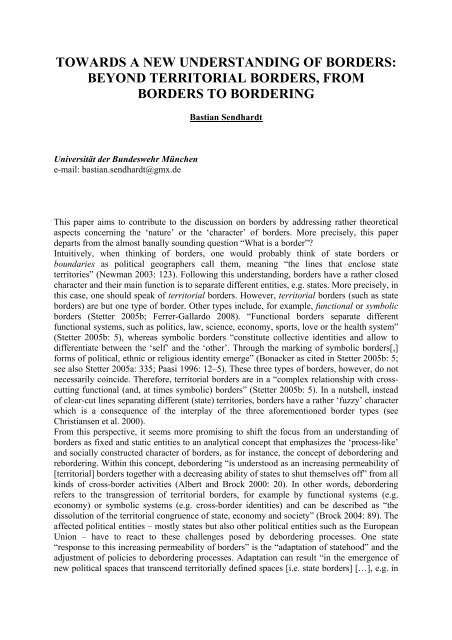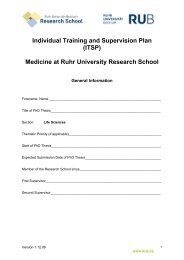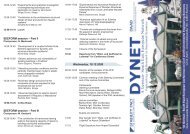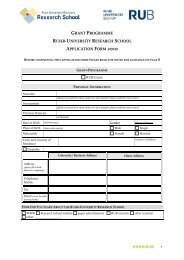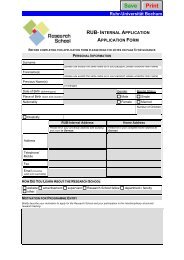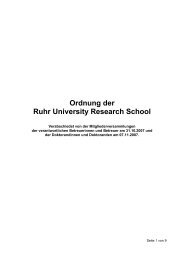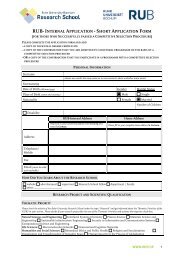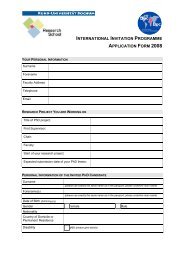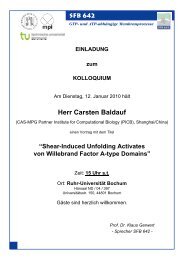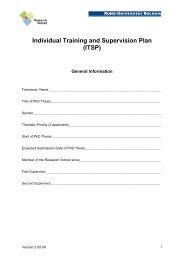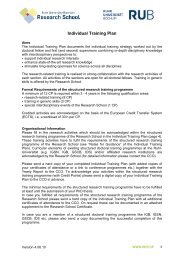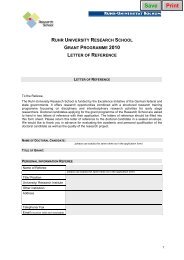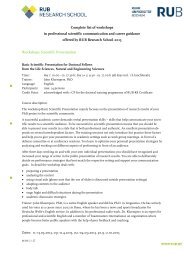Section Days abstract book 2010.indd - RUB Research School ...
Section Days abstract book 2010.indd - RUB Research School ...
Section Days abstract book 2010.indd - RUB Research School ...
Create successful ePaper yourself
Turn your PDF publications into a flip-book with our unique Google optimized e-Paper software.
TOWARDS A NEW UNDERSTANDING OF BORDERS:<br />
BEYOND TERRITORIAL BORDERS, FROM<br />
BORDERS TO BORDERING<br />
Universität der Bundeswehr München<br />
e-mail: bastian.sendhardt@gmx.de<br />
Bastian Sendhardt<br />
This paper aims to contribute to the discussion on borders by addressing rather theoretical<br />
aspects concerning the ‘nature’ or the ‘character’ of borders. More precisely, this paper<br />
departs from the almost banally sounding question “What is a border”?<br />
Intuitively, when thinking of borders, one would probably think of state borders or<br />
boundaries as political geographers call them, meaning “the lines that enclose state<br />
territories” (Newman 2003: 123). Following this understanding, borders have a rather closed<br />
character and their main function is to separate different entities, e.g. states. More precisely, in<br />
this case, one should speak of territorial borders. However, territorial borders (such as state<br />
borders) are but one type of border. Other types include, for example, functional or symbolic<br />
borders (Stetter 2005b; Ferrer-Gallardo 2008). “Functional borders separate different<br />
functional systems, such as politics, law, science, economy, sports, love or the health system”<br />
(Stetter 2005b: 5), whereas symbolic borders “constitute collective identities and allow to<br />
differentiate between the ‘self’ and the ‘other’. Through the marking of symbolic borders[,]<br />
forms of political, ethnic or religious identity emerge” (Bonacker as cited in Stetter 2005b: 5;<br />
see also Stetter 2005a: 335; Paasi 1996: 12–5). These three types of borders, however, do not<br />
necessarily coincide. Therefore, territorial borders are in a “complex relationship with crosscutting<br />
functional (and, at times symbolic) borders” (Stetter 2005b: 5). In a nutshell, instead<br />
of clear-cut lines separating different (state) territories, borders have a rather ‘fuzzy’ character<br />
which is a consequence of the interplay of the three aforementioned border types (see<br />
Christiansen et al. 2000).<br />
From this perspective, it seems more promising to shift the focus from an understanding of<br />
borders as fixed and static entities to an analytical concept that emphasizes the ‘process-like’<br />
and socially constructed character of borders, as for instance, the concept of debordering and<br />
rebordering. Within this concept, debordering “is understood as an increasing permeability of<br />
[territorial] borders together with a decreasing ability of states to shut themselves off” from all<br />
kinds of cross-border activities (Albert and Brock 2000: 20). In other words, debordering<br />
refers to the transgression of territorial borders, for example by functional systems (e.g.<br />
economy) or symbolic systems (e.g. cross-border identities) and can be described as “the<br />
dissolution of the territorial congruence of state, economy and society” (Brock 2004: 89). The<br />
affected political entities – mostly states but also other political entities such as the European<br />
Union – have to react to these challenges posed by debordering processes. One state<br />
“response to this increasing permeability of borders” is the “adaptation of statehood” and the<br />
adjustment of policies to debordering processes. Adaptation can result “in the emergence of<br />
new political spaces that transcend territorially defined spaces [i.e. state borders] […], e.g. in


